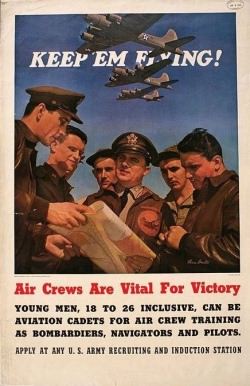| The Effect of the North American P-51 Mustang On the Air War in Europe by David Buckingham |
||||
|
The Installation of the Merlin Engines So, for the next eighteen months, the P-51A's continued to fly with the RAF, doing their unexceptional jobs well. After the plane began to go into combat, some people began looking into the idea of fitting the Mustang with a more powerful engine. As the RAF said, it was "a bloody good airplane, only it needs a bit more poke." (Grant 22) One day, an RAF test pilot was flying a P-51A and the thought occurred to him that the plane could be fitted with a Rolls-Royce Merlin engine, which had about 300 more horsepower and included a supercharger. He suggested it to Rolls-Royce's Chief Aerodynamic Engineer and "both men realized that the combination of this sort of performance with the aerodynamically efficient airframe of the Mustang would revolutionize its potential." (Grant 22) This plan was duly carried out and in November 1943, the first group of P-51B's arrived in England. Features, Advantages, and Benefits of the P-51 This final Mustang design was superior to anything else that flew at the time. The P-51B had a huge internal gasoline tank capacity (around 425 gallons) and its engine was very economical, using about half the gasoline of other American fighters. This meant its range was 1080 miles and could be extended to 2600 miles when extra drop-tanks were attached to the wings. This made its range far more than any Allied or German fighter's. As far as performance went, it was superior to all others as well. Neither of the other two main American fighters could compete; the P-47 was too heavy and the P-38 had too many technical problems. The British fighters, the Spitfire and the Hurricane, did not have the range, speed, or power. But most important was its superiority over the German fighters, the best of which were the FW-190 and the Me-109. The Mustang was 50 mph faster than the Germans up to 28,000 ft., beyond which it was much faster than the FW-190 and still substantially faster than the Me-109. The Mustang had between 3000 and 4000 lbs. more weight, and so was able to outdive either German plane. The tightness of its turns was much better than the Me-109 and slightly better than the FW-190. (Grant 31, Boyne 389-390, Bailey 153) The result of all of this was that the Allies now had a plane that could go with the bombers all the way to and from their targets, fight and defeat the bombers' German attackers, and not run out of fuel. The P-51's Battle Performance So, at the end of 1943 and the beginning of 1944, the new American P-51B's began arriving in England in force. (Dupuy 34) For the first few months of the year, the Mustangs were settling in and having their systems perfected. But by March, the Mustangs had decisively taken control. The arrival and subsequent heavy use of the P-51's had several effects. |
 The first effect that the Mustangs had was in the running air battles over Europe. Before the beginning of 1944, the bombers had been alone as they approached their faraway targets. But the P-51 changed this, and quickly made an impression on all concerned, enemy and ally alike. For example, on January 11, 1944, the Eighth Air Force launched its first deep penetration of Germany with P-51 coverage. The bombers' targets were the cities of Oschersleben and Halberstadt, where many German planes were being constructed. When they arrived, there were 49 Mustangs covering a force of around 220 bombers. Even though the bombers suffered heavy casualties, they were able to inflict substantial damage on their target factories. But the most significant thing about the battle was the shining performance of the P-51's. Since the bombers were attacking two different cities, the Mustang force had to divide into two groups, to support the different attacks. Because of the sensitive nature of the bombers' targets, the Luftwaffe came out in force to defend their factories. During the ensuing melee, the 49 P-51's shot down 15 enemy planes without suffering a single loss. Major Howard, the group's leader, was credited with four kills within minutes. (Bailey 155) In the grand scheme of things, this battle was insignificant, but it goes to show how much of an advantage the P-51's had over their German counterparts. Considering that these were essentially first-time pilots in the Mustangs' first big battle, this is very impressive. Go to The Change in Policy on Escort Fighter
|
|||
|
Copyright © 1997 - 2000 COMBATSIM.COM, INC. All Rights Reserved. Last Updated August 27th, 1999 |
||||
